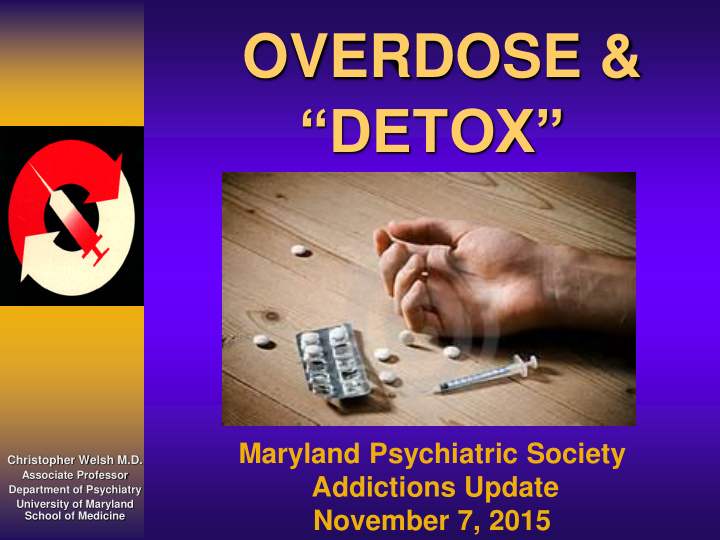



OVERDOSE & “DETOX” Maryland Psychiatric Society Christopher Welsh M.D. Associate Professor Addictions Update Department of Psychiatry University of Maryland November 7, 2015 School of Medicine
OPIOID OVERDOSE Drowsiness, Small pupils, Apathy Slurred Speech, Inattention to environment Unconscious, Blue skin, Pinpoint Pupils, Slow (less than 4-6 times/min) or labored breathing, “Death rattle” Death
RISK FACTORS FOR OD Recent period of abstinence – Incarceration – Hospitalization (medical, psychiatric) – Residential Addiction program – Out- patient “Detox” Respiratory compromise (sleep apnea, etc) Mental health/Substance Use Disorder Using alone Using in unfamiliar surroundings Changes in the “cut” Mixing drugs – Especially benzodiazepines or alcohol
INITIATION OF DRUG USE >12 Y.O.(2013; NHSDU)
INITIATION OF DRUG USE >12 Y.O.(2008; NHSDU)
Rates of Use in Maryland Percentage of Maryland youth who have tried the following drugs at least once
“The US accounts for 4% of the world’s The US accounts for 5% of the world’s population population but uses 80% of its prescription but uses >80% of its prescription opioids opioid” International Narcotics Control Board for the UN; 2010
UNINTENTIONAL “POISONING” Leading cause of unintentional injury death in U.S. Leading cause in 35-54 year olds Leading cause in many states Leading cause of death in celebrities???
io
io
Unintentional Death: MVC vs “Poisoning”
Number of opioid-analgesic poisoning deaths, by involvement of benzodiazepines: United States, 1999 – 2011 Benzodiazepines were involved in 31% of the opioid-analgesic poisoning deaths in 2011, up from 13% of such deaths in 1999.
UNINTENTIONAL OPIOID OVERDOSE DEATHS PARALLEL OPIOID SALES Sales of OPR quadrupled between 1999 & 2010 -Enough for every American to take 5 mg Vicodin every 4 hrs for 4 weeks -5,500 new prescription opioid users per day -5.1 million Americans currently abuse prescription opioids
Nearly $130 billion of the fatal injury costs were attributable to unintentional injuries, followed by suicide ($50.8 billion) and homicide ($26.4 billion). Drug poisonings, including prescription drug overdoses, accounted for 27% of fatal injury costs.
Crude Death Rates for Total Intoxication Deaths by Place of Residence, Maryland, 2007-2012.
=
=
=
=
POSSIBLE INTERVENTIONS 1º, 2º, 3º, 4º Education/Public Awareness Legislation Early Warning Network- Interagency Collaboration – Local Overdose Fatality Review Teams Increased Drug Treatment Prescription Drug Monitoring Programs Physician Prescribing Education Prescription Medication Take-Back Naloxone Distribution (3 rd party, law enforcement, co-prescribing) Assistance for loved ones Safe Injection Rooms/Prescribed Heroin
Health-General §§ 13-3101-3109 effective Oct. 1, 2013 Federal Lawmakers Introducing COMAR 10.47.08.01-.11 Overdose Prevention Bill to effective Mar. 3, 2014. Combat Heroin and Opioid Overdose Crisis Md. law protects people seeking help for overdose victims
Prescription Drug Monitoring Program (PDMP) ( aka “CRISP”)
FORMS OF NALOXONE Pre-loaded single-dose syringes Single-dose glass ampules Multi-dose 10cc bottles Talking auto injector Nasal spray* *Not yet FDA approved
Baltimore to Give Heroin Users Overdose Drug March 7, 2003 Communities in Action This spring, Baltimore health officials are planning to launch a program that will enable heroin users to inject naloxone, an opiate-blocking drug used to revive a person who overdoses, the Baltimore Sun reported March 3. Health officials said the program is aimed at curbing the rising number of fatal heroin overdoses. "There is a chronic problem here," said Dr. Peter L. Beilenson, Baltimore health commissioner. "A significant number of people are dying each year from heroin overdoses -- in one year, more than the homicide rate -- and while this may be viewed as enabling, this is a worthwhile attempt to keep people alive." Under the program, vials of the drug Narcan would be distributed to heroin users, who will receive training from emergency-services and health officials. Narcan is used in the medical community to treat opium- based narcotics overdoses.
Overdose Response Program Training & Dispensing Statistics* As of October 16, 2015 Individuals Trained Under the ORP* FY 14 1,431 FY 15 7,524 FY 16* 2,499 thru October 16, 2015 Total* 11,184 Doses of Naloxone Dispensed* FY 14 1,741 = FY 15 6,279 FY 16* 3,382 thru October 16, 2015 Total* 11,402 Administrations of Naloxone Reported** FY 14 14 FY 15 131 FY 16* 71 thru October 16, 2015 Total* 216 * Training and dispensing statistics are maintained by authorized training entities and reported to DHMH on a monthly basis. ** Naloxone administration information is voluntarily reported by certificate holders to the Maryland Poison Center or to an authorized training entity and subsequently provided to DHMH on a monthly basis.
“DETOX” “The liver detoxifies but clinicians manage withdrawal.” ASAM = “Withdrawal Management”
“DETOX” Should we be “detoxing” most patients? – High relapse rates – Lack of good data – Legal limitations – Law suits
“DETOX” The Controlled Substances Act (1970) – …to administer/dispense a “narcotic” drug for the purposes of maintenance or detoxification: the practitioner must be separately registered with the DEA as a narcotic treatment program… and must be in compliance with DEA regulations… – Exceptions: Incidental Exception : “… in a hospital to maintain or detoxify a person if such action is incidental adjunct to medical or surgical treatment of conditions other than addiction.” Relief of Acute Withdrawal Symptom Exception : “…administer (but not prescribe) narcotic drugs ‘to a person for the purpose of relieving acute withdrawal symptoms when necessary while arrangements are being made for referral for treatment’ …may not administer more than one day’s medication at one time and such treatment may not last for more than three (3) days; no renewals or extensions of that period are permitted.”
So What’s A Psy Psychia hiatrist trist To Do? o Do? Use the PDMP!!! Prescribe controlled substances thoughtfully Communicate with other medical/mental health providers Refer/consult in situations that are out of your comfort zone
Recommend
More recommend